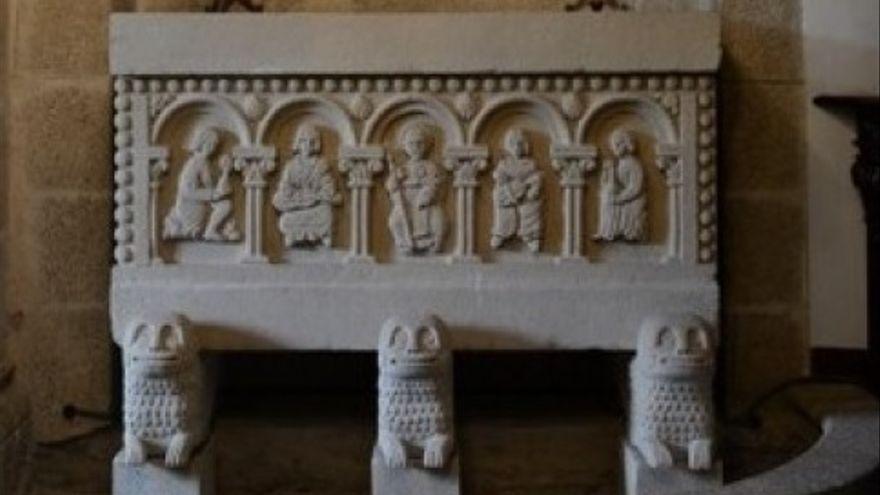The Court of First Instance number 1 of A Coruña He already has in his possession one of the expert reports commissioned by the grandchildren of dictator Francisco Franco to defend the transfer of movable property from the Meirás pazo at the hearing to be held on January 13 and 14.
The architect Ramon Blas Tojo focuses your report on the 55 elements on which the State and the Martínez Bordiú brothers disagree and that include, among others, the sculptural ensembles of the garden or the elements of the chapel, including the sarcophagus that he had carved Emilia Pardo Bazán, in which she wanted to be buried, oel Christ with natural hair which he described in detail in his novel ‘The Chimera’.
These goods are part of the 133 items that State advocacy he claims in his execution incident alleging that it is real estate by incorporation (which cannot be removed without causing a damage to the building) or by destination (which were placed with a vocation of permanence).
The Franco expert does not assess the intention with which the elements were installed and limits his report to assessing whether they can be moved without causing damage to them or to the structure that supports them. From this point of view, this specialist, who appraised the 55 goods in dispute with the help of a stonemason and a carpenter, concludes that all the goods claimed by the Francs are displaceable except for five: the three shields of the Duchy of Franco, the monolith stone garden to commemorate the visit of Alfonso XIII Y Victoria Eugenia in 1927 and cordovan of the altar of the chapel. Blas Tojo concludes that the disassembly of the coats of arms of the Duchy of Franco of the façade and those incorporated into the stone ensembles of the gardens could cause damage both to the blazons themselves and to the architecture that surrounds them. Regarding the monolith, the expert warns that “in the absence of more inclusive tastings”, it is not recommended to dismantle it for transfer “since it will probably suffer considerable damage.”
The other fifty elements are movable, concludes the architect, including the sarcophagus that he ordered to carve. Emilia Pardo Bazán. His transfer is “perfectly viable”, affirms this expert, who argues that “it was not made to measure for his current location.”
The expert argues that the sarcophagus “was not made to measure for its current location”
Also consider removable other pieces of the chapel from the countess’s time, such as the Christ with natural hair. Its movement, he points out, “is as simple as unhooking it from the anchors.”
The sizes of the baroque altarpiece, the holy water font, the confessional made of wood are other “movable” elements, as is the carved wooden door that separates the chapel from the vestibule and that the Francos also intend to take away. “Obviously, like all doors, it can be lowered and moved.”
The hallway rugs, glued with double-sided tape and staples, the sculptural sets and the garden tables o la baptismal font converted into a pot are also movable, concludes the expert in a report of 66 pages.
The expert focuses on the assets at issue between the Condition and the Franco, but does not pronounce on him execution incident of Sada Town Hall, that the Francs tried unsuccessfully to have it rejected due to lack of legitimacy and to which the State will adhere at the hearing. In this incident, the Sadense City Council defends that all property should remain in Meirás except those that the Francos prove that they were installed after the death of the dictator.
He argues that it is about real estate by destination, incorporated with the vocation of permanence or installed by the State during the dictatorship and which remained at the head of the State. He also points out in his incident that the furniture, works of art and furnishings from the time of Pardo Bazán They were sold with the pazo in 1938 (except the library and some tapestries), as stated in the writing, and that there are elements that were displaced to Meirás from other state agencies during the dictatorship, as detailed in a report from National Heritage.
The Francos have now appealed the expert witness of the Sada City Council after failing in their attempt to have their incident not admitted
The Sada Town Hall supports his incident in an expert report made by the historian Manuel Pérez Lorenzor that details assets hitherto ignored from the times of Pardo Bazán and others incorporated by the State.
The Franco They have now filed an appeal against this expert alleging that it was submitted in an untimely manner, an extreme that the City Council rejects.
www.informacion.es
Eddie is an Australian news reporter with over 9 years in the industry and has published on Forbes and tech crunch.
